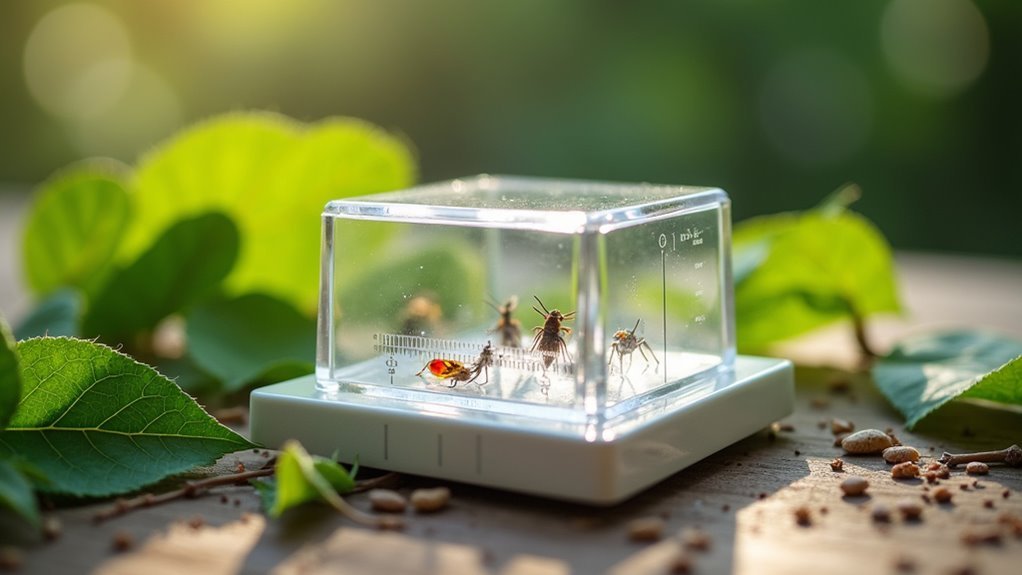You can create highly effective pest control by strategically positioning companion plants in specific layouts throughout your garden. The Three Sisters configuration combines corn, beans, and squash for natural defense, while perimeter plantings of aromatic herbs like rosemary and sage form protective barriers. Position trap crops like nasturtiums 12-18 inches from main plants to draw pests away, and establish marigold borders to eliminate root-knot nematodes. These proven layouts will transform your garden’s natural defenses.
Understanding Strategic Companion Plant Placement for Maximum Pest Control

When you strategically place companion plants throughout your garden, you’re fundamentally creating a natural defense system that works around the clock to protect your crops from harmful pests.
Companion planting relies on strategic placement to maximize these protective benefits. The Three Sisters Method demonstrates this principle perfectly—corn supports beans while squash acts as living mulch, creating multiple layers of defense.
Strategic companion planting creates multi-layered garden defenses, with each plant serving a specific protective role in your natural pest management system.
You’ll achieve excellent pest control by implementing trap crops like nasturtiums, which lure destructive insects away from valuable plants.
Aromatic herbs such as rosemary and mint function as natural barriers, masking vulnerable crops’ scents.
Marigolds release thiophene compounds that eliminate root-knot nematodes on contact, while basil repels whiteflies from tomatoes.
This approach also attracts beneficial insects that prey on garden pests, establishing sustainable protection.
The Three Sisters Layout: Ancient Wisdom for Modern Pest Management
You can harness one of agriculture’s most effective companion planting systems by adopting the Three Sisters layout, a time-tested Native American technique that naturally deters pests through plant diversity.
This ancient method creates a living fortress against harmful insects while maximizing your garden’s productivity in minimal space.
You’ll discover that corn, beans, and squash work together as nature’s own pest management team, disrupting insect lifecycles and attracting beneficial predators to protect your crops.
Ancient Native American Technique
While modern gardeners often struggle with complex fertilization schedules and pest control methods, Native American communities developed an ingenious solution centuries ago that’s as relevant today as it was then.
This ancient technique involves planting three sisters—corn, beans, and squash—together in a sustainable partnership that maximizes your garden’s potential.
You’ll discover that corn provides sturdy support for climbing beans, while beans naturally enrich your soil with nitrogen that feeds both corn and squash.
The squash’s broad leaves create a living mulch that suppresses weeds and retains moisture.
This strategic arrangement minimizes root competition since each plant occupies different soil zones, reducing pest issues while promoting healthy growth and fostering biodiversity in your garden ecosystem.
Natural Pest Defense System
Beyond these foundational benefits, the Three Sisters configuration creates a sophisticated natural pest defense system that outperforms many modern chemical interventions.
This companion planting involves three crops that help keep pests away through multiple mechanisms. Beans enriching the soil with nitrogen support robust corn and squash growth, making plants less susceptible to pest damage.
The diverse plantings attract beneficial insects like ladybugs and parasitic wasps that naturally control harmful pests. Squash’s broad leaves create ground cover that eliminates pest breeding sites while enhancing soil moisture retention.
When these plants work together, they create a synergistic pest management system that’s both effective and sustainable. This natural pest management approach demonstrates how enhancing soil health and biodiversity provides superior protection compared to isolated monocultures.
Space-Efficient Planting Strategy
When you’re working with limited garden space, the Three Sisters layout transforms how efficiently you can grow food by stacking plants both horizontally and vertically. This companion planting strategy maximizes your garden’s potential by positioning each crop in different root zones, eliminating competition for nutrients.
| Plant | Function | Benefit |
|---|---|---|
| Corn | Vertical support structure | Creates climbing framework |
| Beans | Nitrogen fixation | Enriches soil naturally |
| Squash | Ground cover mulch | Suppresses weeds, retains moisture |
| Combined | Pest deterrent system | Attracts beneficial insects |
You’ll discover this space-efficient method reduces your need for chemical interventions while increasing yields. The beans add essential nitrogen in the soil, supporting all three plants’ growth. This ancient planting wisdom creates a natural defense against pests while promoting biodiversity in your companion garden.
Perimeter Defense Gardens: Using Aromatic Herbs as Natural Barriers
As gardeners search for sustainable pest management solutions, aromatic herbs emerge as powerful allies in creating natural barriers around garden perimeters.
Strategic companion planting of mint, rosemary, sage, and chives along garden edges creates effective perimeter defense against aphids, flea beetles, and cabbage moths. These pest deterrents release strong scents that repel harmful insects while simultaneously attracting beneficial insects like predatory species that enhance your garden ecosystem.
Three key advantages of aromatic herb perimeter defense:
- Dual-purpose barriers – Herbs like thyme and lavender provide structural support for taller plants while deterring pests.
- Pollinator magnets – Interspersing herbs with flowering plants attracts beneficial pollinators and predatory insects.
- Chemical-free protection – Natural barriers reduce pest invasions without requiring harmful pesticides, promoting healthier growing environments.
Sacrificial Plant Zones: Drawing Pests Away From Valuable Crops

You can create sacrificial plant zones by strategically placing nasturtiums 12-18 inches away from your valuable crops to act as living pest magnets.
This trap cropping method works because nasturtiums naturally attract aphids, beetles, and other harmful insects that would otherwise target your main plants.
Plan for continuous protection by staggering new nasturtium plantings every 2-3 weeks, ensuring there’s always fresh bait available to keep pests concentrated away from your harvest.
Nasturtium Trap Cropping
Since nasturtiums naturally attract common garden pests like aphids and whiteflies, they’re perfect for creating sacrificial plant zones that draw harmful insects away from your valuable crops. This trap cropping strategy concentrates pests on nasturtiums while protecting your main vegetables.
Here’s how to implement effective nasturtium trap cropping:
- Strategic placement – Position nasturtiums 12-18 inches from valuable crops to create an irresistible pest magnet without overcrowding your garden layout.
- Succession planting – Stagger new nasturtium plantings every 2-3 weeks to maintain continuous protection throughout the growing season.
- Dual-purpose benefits – Harvest the entire edible plant for culinary use while maintaining pest management effectiveness.
This natural pest control method reduces pesticide reliance and promotes a healthier ecosystem in your garden.
Strategic Placement Distance
While many gardeners instinctively want to keep pest-attracting plants far from their crops, the most effective sacrificial plant zones actually require precise proximity to work properly.
Strategic placement of companion plants like nasturtiums demands positioning them 12-18 inches from your valuable crops. This distance guarantees sacrificial plants successfully intercept destructive insects before they reach your main plantings.
You’ll maximize pest-repelling efficiency by creating dedicated zones where these plant combinations work together.
Position sacrificial plants near your most vulnerable crops to enhance their protective capabilities. This strategic placement approach reduces chemical interventions while boosting overall garden health through calculated biodiversity.
When you establish these zones correctly, you’ll attract beneficial insects while drawing harmful pests away from crops that matter most to your harvest success.
Continuous Protection Planning
Perfect spacing becomes meaningless without proper timing to maintain your sacrificial plant defenses throughout the growing season.
You’ll need staggered plantings every 2-3 weeks to guarantee continuous pest protection as insects emerge in waves. Strategic placement combined with timing creates an unbreakable protective buffer around your valuable crops.
Your continuous protection plan should include:
- Sequential nasturtium plantings – Start new seeds while previous plants are actively trapping aphids and beetles.
- Coordinated plant pairings – Combine marigolds with nasturtiums so they support each other’s growth while targeting different pests.
- Perimeter rotation schedule – Replace spent sacrificial plants before pest populations relocate to main crops.
This systematic approach attracts beneficial insects while maintaining constant pest control, assuring your garden’s defenses never weaken during critical growing periods.
Beneficial Insect Corridors: Creating Habitats for Garden Allies

When you create beneficial insect corridors in your garden, you’re establishing vital highways that attract and support nature’s most effective pest controllers.
Creating beneficial insect corridors transforms your garden into a superhighway system where nature’s best pest controllers thrive and patrol your plants.
These corridors work by strategic placement of diverse plantings along borders and pathways, encouraging predatory insects like ladybugs and lacewings to patrol your crops.
You’ll want to create habitats using plants with umbrella-shaped flowers such as dill and fennel, which serve as landing platforms for attracting beneficial insects.
Include flowering herbs and native plants to provide essential food sources and shelter.
Maintaining continuous bloom throughout the growing season guarantees your garden allies have steady nutrition, strengthening their populations and enhancing their pest management capabilities.
This approach builds a balanced ecosystem where beneficial insects naturally control harmful pests.
Trap Crop Configurations: Strategic Positioning for Pest Interception
You’ll transform your garden’s pest management by positioning trap crops as strategic decoys that draw harmful insects away from your prized vegetables.
The key lies in placing these sacrificial plants at precise distances—typically 12-18 inches from your main crops—while timing their planting to intercept pests throughout the growing season.
Sacrificial Plant Placement Strategy
Strategic placement of sacrificial plants transforms your garden into a tactical defense system where decoy crops intercept pests before they reach your prized vegetables.
You’ll create an effective protective barrier by strategically placing these trap crops around your garden’s perimeter, establishing the first line of defense against destructive insects.
Your sacrificial plants should be positioned 12-18 inches from main crops to optimize pest attraction while maximizing space utilization. This strategic spacing guarantees pests concentrate on decoy plants rather than valuable vegetables.
Essential Placement Strategies:
- Perimeter positioning – Ring your garden with nasturtiums and blue hubbard squash to intercept incoming pests.
- Staggered timing – Plant new trap crops every 2-3 weeks for continuous pest control coverage.
- Biodiversity enhancement – Integrate multiple sacrificial species to enhance biodiversity while targeting different pest varieties.
Distance and Timing Considerations
While proper spacing forms the foundation of trap crop success, timing your plantings creates the crucial window that determines whether pests target your decoys or devastate your main crops.
You’ll want to maintain a 12-18 inch distance between trap crops and valuable crops, ensuring pests find your sacrificial plants first without compromising your harvest.
Plant trap crops 1-2 weeks earlier than your main plantings to establish attractive targets before pests arrive. Implement staggered planting every 2-3 weeks for continuous pest control throughout the growing season.
Choose bright yellow flowering varieties that provide visual cues for insects like squash bugs.
Regular monitoring becomes essential once trap crops mature, allowing you to remove infested plants before pests migrate back to your valuable crops.
Multi-Crop Protection Zones
When multiple crop types grow in close proximity, creating overlapping protection zones becomes your most powerful defense against diverse pest populations.
Strategically planting trap crops like nasturtiums and marigolds creates interconnected barriers that enhance crop protection while allowing beneficial insects to thrive throughout your garden.
Multi-zone configuration strategies:
- Staggered perimeter defense – Position different trap crops at varying distances from main crops, with marigolds closest (12 inches) and blue hubbard squash further out (18 inches) for layered pest attraction.
- Continuous replacement cycles – Plant new trap crops every 2-3 weeks to maintain fresh pest attraction while protecting neighboring plants throughout the season.
- Visual monitoring networks – Establish regular inspection routes between protection zones for effective monitoring pests and evaluating overall garden health.
This systematic approach maximizes your garden’s natural defenses.
Marigold Border Systems: Establishing Nematode-Free Growing Zones
Marigolds serve as nature’s own pest control system, releasing thiophene compounds that kill root-knot nematodes on contact while creating protective barriers around your most vulnerable crops.
French marigolds offer the strongest pest control properties, making them ideal for protecting tomatoes, peppers, and eggplants from destructive nematode damage.
Establish your marigold borders by spacing plants 12-18 inches from main crops around vegetable beds. This strategic placement maximizes nematode trapping while allowing your primary plants to flourish.
The borders also attract beneficial insects like pollinators and predatory bugs, enhancing your garden’s natural ecosystem balance.
Plant marigolds continuously throughout the growing season to maintain consistent protection. This approach guarantees ongoing soil health improvement while keeping nematode populations suppressed year-round.
Herb and Vegetable Integration Patterns for Optimal Protection
Beyond perimeter defenses, you can create layered protection by weaving aromatic herbs directly among your vegetable rows.
This herb and vegetable integration provides natural pest deterrence while attracting beneficial insects to your garden ecosystem. Your strategic layout should focus on companion planting that’ll repel harmful insects naturally.
Effective Integration Patterns:
- Aromatic Barriers – Plant rosemary and thyme around crop perimeters to create protective zones that deter pests while drawing in beneficial pollinators and predators.
- Root Zone Protection – Position chives and garlic near carrots and potatoes to repel destructive nematodes and aphids at soil level.
- Nitrogen-Fixing Triangles – Arrange beans with corn and squash in triangular formations to improve overall garden health through natural soil enrichment and space optimization.
Vertical Companion Planting: Maximizing Space While Controlling Pests
While horizontal planting maximizes ground coverage, vertical companion planting transforms your garden into a three-dimensional ecosystem that doubles your growing capacity while creating natural pest barriers. You’ll maximize space by using tall crops like corn or sunflowers as living trellises for climbing beans, while positioning pest-repelling plants like herbs like basil and marigolds at ground level.
| Support Plant | Climbing Partner | Base Layer Companion |
|---|---|---|
| Corn | Pole beans | Squash/basil |
| Sunflowers | Cucumbers | Marigolds |
| Tomato cages | Peas | Lettuce/chives |
| Bean poles | Morning glories | Nasturtiums |
This strategy enables effective pest control through beneficial insects attraction while ground-level companions suppress weeds and retain moisture. You’ll create multi-layered garden zones that reduce light competition and eliminate chemical interventions through natural pest management.
Seasonal Layout Rotations: Adapting Companion Strategies Throughout Growing Seasons
As seasons change, your companion planting strategy must evolve to maintain soil health and maximize harvest potential throughout the year.
Seasonal layout rotations optimize companion relationships while preventing pest buildup and soil depletion. You’ll need to rotate crops strategically, moving nitrogen-fixing legumes before heavy feeders like corn or tomatoes to boost nutrient content naturally.
Effective planting strategies include:
- Winter cover crops – Plant clover or rye to improve soil structure and prepare for spring planting
- Staggered companion timing – Start with basil alongside tomatoes, then follow with marigolds for continuous pest control
- Seasonal monitoring – Track which companion relationships work best and adjust layouts accordingly
This adaptive approach attracts beneficial insects while maintaining effective pest control throughout changing environmental conditions.
Frequently Asked Questions
How Can Companion Planting Help With Pest Management?
You’ll naturally repel pests by pairing specific plants together. Basil deters tomato hornworms, marigolds kill harmful nematodes, and aromatic herbs attract beneficial insects while repelling destructive ones, reducing your need for chemical pesticides.
Which Companion Plant Repels Flies and Ants?
You’ll find rue works best for repelling both flies and ants while attracting beneficial insects like ladybugs. Mint’s also effective against both pests, but you’ll need containers to control its spreading.
How Do You Space Companion Plants?
You’ll space companion plants based on their growth habits and root systems. Place taller plants north of shorter ones, maintain 10-12 inches between most companions, and position sacrificial plants 12-18 inches from main crops.
What Is the Best Control Measure for Garden Pests Is Prevention?
You’ll find prevention’s the most effective garden pest control because it stops infestations before they start. You’re creating barriers through strategic planning, companion planting, and regular monitoring rather than reacting to problems.
In Summary
You’ve now got the blueprint for transforming your garden into a natural pest control fortress. Don’t rely on chemicals when strategic companion planting can do the work for you. Start small with one layout that appeals to you, then expand your system as you gain confidence. Remember, you’re creating an ecosystem that’ll protect itself while feeding your family. Your garden’s success depends on these thoughtful partnerships between plants.





Leave a Reply